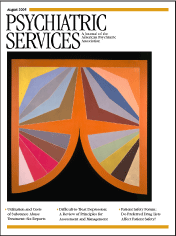The Costs and Outcomes of Treatment for Opioid Dependence Associated With Posttraumatic Stress Disorder
Abstract
OBJECTIVE: This study examined the costs and outcomes of treatment for opiate dependence associated with posttraumatic stress disorder (PTSD). METHODS: Data were collected on the use of opiate treatment over a 12-month period for a cohort of 495 individuals, of whom 42 percent had PTSD. Total treatment costs were calculated as the sum of the time spent in each treatment modality multiplied by the appropriate unit cost. Outcome measures included occupational functioning, use of heroin and other drugs, and physical and mental health. RESULTS: No significant difference was noted in the cost of treatment over the 12-month period for persons with and without PTSD ($5,394±5,136 and $4,821±5,144 [Australian dollars], respectively). However, persons with PTSD had poorer treatment outcomes in terms of occupational functioning, overdose, and physical and mental health. CONCLUSIONS: Although the same resources were invested in opiate treatment for persons with and without PTSD, PTSD continued to be associated with poorer functioning in a number of domains at 12-month follow-up. A well-designed intervention targeting both heroin dependence and PTSD may help to improve the outcomes of persons with PTSD.



